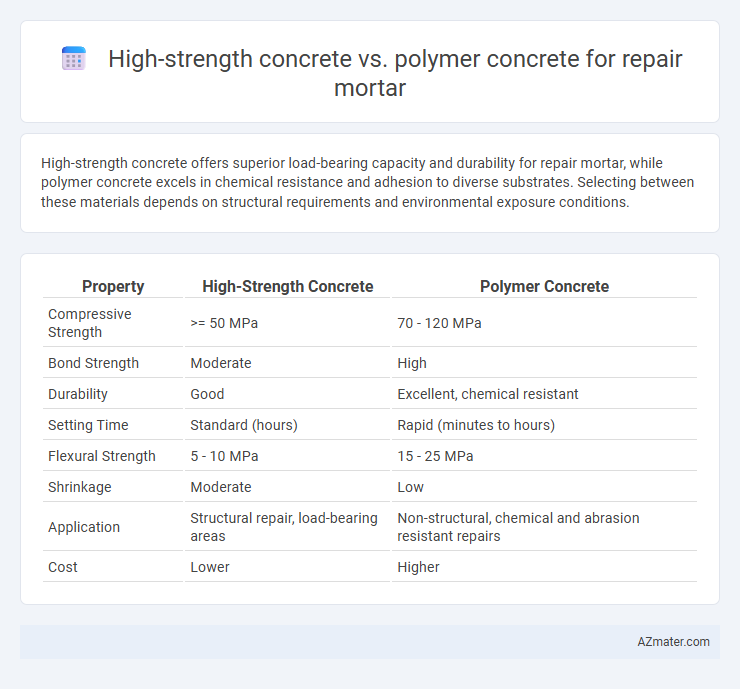High-strength concrete offers superior load-bearing capacity and durability for repair mortar, while polymer concrete excels in chemical resistance and adhesion to diverse substrates. Selecting between these materials depends on structural requirements and environmental exposure conditions.
Table of Comparison
| Property | High-Strength Concrete | Polymer Concrete |
|---|---|---|
| Compressive Strength | >= 50 MPa | 70 - 120 MPa |
| Bond Strength | Moderate | High |
| Durability | Good | Excellent, chemical resistant |
| Setting Time | Standard (hours) | Rapid (minutes to hours) |
| Flexural Strength | 5 - 10 MPa | 15 - 25 MPa |
| Shrinkage | Moderate | Low |
| Application | Structural repair, load-bearing areas | Non-structural, chemical and abrasion resistant repairs |
| Cost | Lower | Higher |
Introduction to High-Strength Concrete and Polymer Concrete
High-strength concrete (HSC) is characterized by compressive strengths exceeding 6,000 psi, offering superior durability and load-bearing capacity for structural repairs. Polymer concrete incorporates polymer resins as binders, significantly enhancing adhesion, chemical resistance, and rapid curing properties compared to traditional cementitious materials. These distinct compositions influence the selection of repair mortar based on project-specific requirements such as environmental exposure, mechanical performance, and application speed.
Composition and Material Properties
High-strength concrete for repair mortar typically consists of Portland cement, fine aggregates, water, and chemical admixtures designed to enhance compressive strength, durability, and workability, achieving compressive strengths exceeding 40 MPa. Polymer concrete integrates polymer resins such as epoxy or polyester with aggregates, offering superior adhesion, chemical resistance, and flexibility compared to traditional cement-based systems. The inclusion of polymers significantly improves tensile strength, reduces permeability, and enhances bond strength to existing substrates, making polymer concrete ideal for specialized repair applications where durability and resistance to aggressive environments are critical.
Key Differences in Mechanical Strength
High-strength concrete typically exhibits compressive strengths exceeding 50 MPa, offering robust load-bearing capabilities but limited flexibility, which can lead to cracking under dynamic stress. Polymer concrete incorporates resins that enhance tensile and flexural strength, providing superior adhesion and resistance to chemical degradation compared to traditional high-strength concrete. The key mechanical strength difference lies in polymer concrete's improved impact resistance and durability in harsh environments, making it more suitable for repair mortars exposed to aggressive conditions.
Durability and Longevity in Repair Mortar Applications
High-strength concrete offers superior compressive strength and resistance to mechanical wear, making it suitable for repair mortar in structural applications with high load demands. Polymer concrete enhances durability through its excellent chemical resistance and reduced permeability, preventing degradation from moisture, chemicals, and freeze-thaw cycles. For repair mortar applications requiring extended longevity in aggressive environments, polymer concrete provides better protection against environmental factors, while high-strength concrete excels in structural performance under heavy stress.
Chemical Resistance and Environmental Performance
High-strength concrete offers robust mechanical properties but generally exhibits moderate chemical resistance, making it less suitable for aggressive chemical environments compared to polymer concrete. Polymer concrete features superior chemical resistance due to its resin-based matrix, effectively withstanding acids, alkalis, and solvents commonly encountered in repair applications. From an environmental performance perspective, polymer concrete can contain recycled materials and reduce CO2 emissions through lower cement content, while high-strength concrete's environmental impact depends heavily on cement type and production methods.
Bonding Abilities to Existing Structures
High-strength concrete offers excellent compressive strength but may exhibit limited bonding ability to existing substrates due to its dense microstructure, which can reduce mechanical interlocking. Polymer concrete, incorporating resin binders, significantly enhances adhesion by creating strong chemical bonds and flexible interfaces with old concrete surfaces, improving repair durability. Studies indicate polymer concrete repairs demonstrate superior bond strength and resistance to delamination compared to traditional high-strength concrete mortars.
Workability and Application Methods
High-strength concrete offers excellent compressive strength but tends to have lower workability, requiring careful water and admixture management for effective placement in repair mortar applications. Polymer concrete enhances workability through its polymer binder, providing superior adhesion and flexibility, which simplifies application methods such as troweling and spraying on irregular surfaces. Choosing polymer concrete often results in faster curing times and improved durability in repair work compared to conventional high-strength concrete.
Cost Comparison and Economic Considerations
High-strength concrete generally offers a lower initial material cost compared to polymer concrete, making it more economical for large-scale repair projects where budget constraints are critical. Polymer concrete, while exhibiting superior chemical resistance and durability, tends to incur higher upfront expenses due to expensive resin components and specialized mixing requirements. Lifecycle cost analysis often favors polymer concrete in aggressive environments, as reduced maintenance and longer service life contribute to overall cost savings despite the higher initial investment.
Best Use Cases for Each Material
High-strength concrete excels in structural repairs requiring enhanced load-bearing capacity and durability, making it ideal for bridge decks, industrial floors, and heavy-duty pavements. Polymer concrete offers superior chemical resistance and excellent adhesion properties, suited for repairing wastewater treatment plants, chemical containment areas, and environments exposed to corrosive substances. Selecting between these materials depends on the specific repair environment and performance requirements such as mechanical strength or chemical resistance.
Conclusion: Choosing the Right Repair Mortar
High-strength concrete offers superior compressive strength and durability, making it ideal for structural repairs requiring load-bearing capacity, while polymer concrete excels in chemical resistance and adhesion, suitable for environments exposed to aggressive chemicals or moisture. Repair mortar selection depends on specific project needs, balancing mechanical performance and environmental exposure to ensure longevity and effectiveness. For structural integrity and heavy-duty applications, high-strength concrete is preferable; polymer concrete is optimal for repair scenarios demanding enhanced bonding and resistance to corrosion.

Infographic: High-strength concrete vs Polymer concrete for Repair mortar
 azmater.com
azmater.com